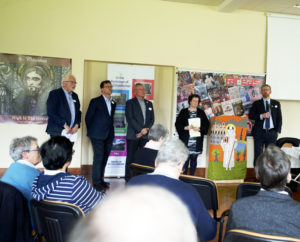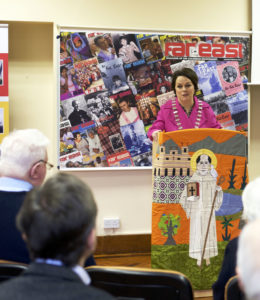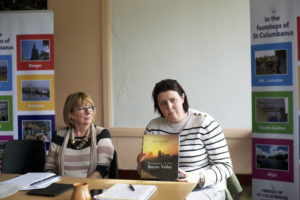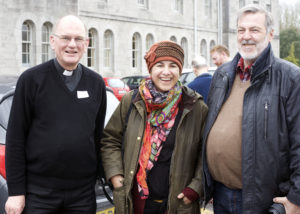A conference on the legacy of St Columbanus in Dalgan Park in April learned about plans for the mapping of ‘The Columban Way’ with the aim of making it into a major cultural route in Europe.
In her address at the opening of the conference, Alderman Deborah Girvan of Ards & North Down Council, who is President of European Association of the Columban Way, told conference delegates that “despite Brexit, this has the potential and is uniting the people of Europe.”
Alderman Girvan added, “So I think it is very important and timely that we are really starting to lift the Columban Way.”
Outlining the priorities of the European Association of the Columban Way, the Northern Ireland politician said one priority was that it would become a cultural route of Europe, but she warned that this would take a lot of effort and a lot of research.
Nevertheless, she suggested that in two years’ time, this might be feasible.
“I hope that within another year or so we will be able to make a public launch of the Columban Way right through Europe, but we will be do it in different stages.”

Brian Nason, Association Friends of St Columbanus ROI, Loreto Guinan, Heritage Officer Meath Co Co, Cllr Suzanne Jamal, Leas Cathaoirleach of Meath Co Co, Alderman Deborah Girvan, President European Association Columban Way, Fr Raymond Husband, Regional Director of Columbans in Ireland, Patsy McLean, President Association Friends of St Columbanus ROI.
The other priority is the mapping of the route. The process is ongoing and is “a huge undertaking” with ‘geotrek’, a satellite navigation system which people can download on to their phone, being used. It provides information on where the next place is on the route, how far is it, how long it will take and where people can stay and eat.
Another priority is recruitment. Alderman Girvan reported that there were six new members of the Association since November 2018 and she paid tribute to Mauro Steffenini from Italy who has been active in recruiting Italian members.
“It is growing all the time – we need that because recruitment is the only way that we can finance the Columban Way to develop the website and to do the promotional activities and to pay for things to get it up and running.”
The Leas Cathaoirleach/Vice Chairperson of Meath County Council, Cllr Suzanne Jamal, also addressed the conference on its opening day, Friday 12 April 2019.
In her address, Cllr Jamal welcomed conference delegates on behalf of the people of Navan and expressed the hope that the Turas Columbanus or the Columban Way would in time become a European cultural route.
Noting that Navan is twinned with Bobbio, the location of St Columban’s death on 23 November 615, she said, “We look forward to deepening those connections and building new connections as we share in this rich cultural legacy.”
Speaking to Columbans.ie, Cllr Jamal said she believed there was “huge potential” for the Columban Way project due to more and more people being focused on health and healthy lifestyles.

David Ward-Perkins, European Association Columban Way, Dr Mauro Steffenini, Secretary European Association Columban Way, Dr Jean Michel Picard, Scientific Community European Association Columban Way, Dr Edel Bhreathnach, historian and members of the RIA, and Dr Alexander O’Hara, Moore Institute at NUIG.
She also paid tribute to the Columbans for making Dalgan Park a resource for the public to use.
“After my mother died in 2005 I came to Dalgan Park a lot and have continued to come here as it is a wonderful amenity – people use it all the time. I think by having a mapped-out segment and advertising that through social media and other means it will attract more people to visit the area.”
Speaking on behalf of the Missionary Society of St Columban, regional director for Ireland, Fr Raymond Husband told conference delegates, some of whom had travelled from the UK, Italy and Switzerland, “This gathering brings together a group of people who are committed to keeping the legacy of St Columbanus alive through academic research and promoting ‘the Columban Way’ pilgrim route across the island of Ireland and continental Europe.”
He continued, “This legacy of St Columban that crosses geographical boundaries of language, culture, politics and religion extends far beyond Europe. For us Columbans, our patron is an inspiration today as we reach out to peoples across Asia, Latin America and Oceania.”

Leas Cathaoirleach of Meath County Council, Cllr Suzanne Jamal.
He said the pilgrim walk, which delegates undertook during the course of the two-day conference, from the Hill of Tara down through Dalgan Woods, would give them a sense of the Columban Way/Turas Columbanus in that part of the Irish countryside.
Dr Mauro Steffenini, President of the Associazione Amici do San Colombano per l’Europa, told the conference that “In the life of St Columbanus we find a marvellous synthesis of the very topical themes of pilgrimage, penance and prayer, especially for Europe.”
He said that through the “rediscovery of the figure of our patron, from a historical perspective, we were able to see how his work and his teaching are still relevant for modern Europe.”

Deborah Girvan and Loreto Guinan.
“It opened us up to the knowledge and making connections with all the Columban realities scattered on the Continent, to the point of creating a great family, where initiatives were undertaken and shared faith experiences.”
The fruit of this initiative was a once-a-year gathering of all Columban communities in an international meeting that takes place in different Columban locations scattered throughout the European continent and which is now in its twenty-second year.

Working group of the European Association of the Columban Way.
Elsewhere in his address, Dr Steffenini said “embracing life as a pilgrimage is the aspect that most identifies St Columbanus, the protagonist of Irish monasticism known as peregrinatio pro Christo and a leading figure in that monastic migration of the 6-7th centuries – during the time of the first new evangelisation of the European continent.”
He added, “One cannot speak of pilgrimages to Europe without considering the journey of St Columbanus, the peregrinus pro Christo par excellence, as the greatest exponent of the nomadic Irish monasticism of the Early Middle Ages.”

Cllr Jim Holloway, Mayor of Navan Council.
According to Dr Steffenini, Christianity cannot be considered in Europe without referring to the marvellous work carried out by Irish missionaries and monks – the basis of the flourishing Christian communities on the Continent and which still constitutes a permanent force for the construction of a new Europe in which the spiritual dimension of men and women and society remains the only guarantee of unity and progress.
Pope Emeritus Benedict XVI had affirmed that Columbanus “can be called a ‘European’ saint.”
“For the first time, in two of his letters, the expression Totius Europae appears with reference to the presence of the church on the continent and aware of the cultural unity of Europe.”

Fr Joe Gunn, PP of St Comgall’s in Bangor with Elizabeth and Josef Schönauer, members of Friends of St Columbanus in St Gallen, Switzerland.
On the theme of faith as a journey, life as a pilgrimage, Dr Steffenini said that those who make the Columban pilgrimage cannot ignore the exhortations of the original and demanding abbot addressed to his monks: “Let us take care of divine things so as not to remain tied to human things; and as true pilgrims the yearning for the homeland is always present in us… we, who are wayfarers, constantly reflect on the goal of the journey (Instruction VIII).”
He said St Columbanus incarnated in every moment of his earthly existence the theme of pilgrimage as a style of an authentically Christian life.
“He is a teacher and guide to the traveller, to the pilgrim, to all those who want to retract his footsteps. His teachings are extremely useful for people and to the believer today who is in a continuous search for the meaning of life and a sense of God.”
“We the friends of St Columbanus have been walking together for years, like a big family on the pathways of Europe, we offer believers and non-believers an original opportunity to be European, to become pilgrims, retracing the same paths of a great European: St Columbanus – that Robert Schuman in 1950 declared as ‘patron of those who work for a united Europe’.”

